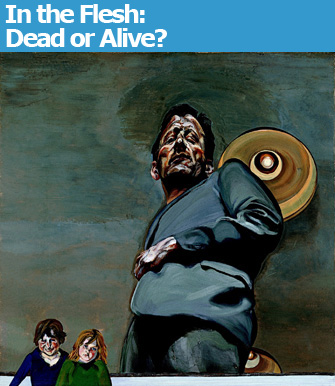 |
|
“Reflection with Two Children (Self-Portrait),” 1965. Photo © José Loren, Museo Thyssen-Bornemiska, Madrid © Lucian Freud |
Lucien Freud says he is not interested in portraying flesh in his paintings, but in making the paint work as flesh. He wants his portraits “to be of people, not like them.” Has he succeeded? Yes, the flesh …
 |
|
“Reflection with Two Children (Self-Portrait),” 1965. Photo © José Loren, Museo Thyssen-Bornemiska, Madrid © Lucian Freud |
Lucian Freud says he is not interested in portraying flesh in his paintings, but in making the paint work as flesh. He wants his portraits “to be of people, not like them.” Has he succeeded? Yes, the flesh seems all too real, but the situations don’t, because there is just too much artifice in his paintings. And that is what makes them interesting, once you get past the initial shock value of his visceral, unflinching way of painting flesh in all its flabby, mottled, imperfect reality.
The exhibition opening today at the Centre Pompidou, “Lucian Freud: Atelier” (through July 19) is the first retrospective of the artist’s work in France in some 25 years. It focuses on the closed world of Freud’s studio, showing how he occasionally lets the outside world in. The show includes a few early paintings, including one Surrealistic interior with a gigantic zebra head entering a room through a window that no one today would ever guess was painted by Freud.
What Freud really seems to be interested in is the messy imperfection of life. Certainly, the flesh is imperfect, but so is just about everything else. The vertical and horizontal lines of the industrial buildings in his early works are off-kilter, and the empty lots next to them are filled with trash. Dead brown leaves mix with the greenery on house and garden plants. Neglect reigns in the studio, filled with piles of rags and furnished with a messy, rudimentary bed, with layers of paint wearing off the walls. A beautiful bouquet of flowers (“Buttercups,” 1968) is not displayed proudly on a table but sits forgotten in the kitchen sink.
Freud is also interested in incongruity and awkwardness. His models, seen from odd angles, are posed in impossible, uncomfortable positions, and people, dogs and things are juxtaposed in bizarre ways. One of the most fascinating paintings here is “Evening in the Studio” (1993), which features one of his famous models, “Big Sue,” an obese woman. The scene depicted seems to have been tilted upward to let us see it from above, giving the whole picture a downward movement. Big Sue is sprawled naked on the floor (Freud always paints the floorboards of his studio with great care) at the bottom of the canvas, her long hair splayed out around her head and her eyes open. She seems to be dead, having tumbled from the bed above her. At the top of the canvas is another woman, clothed, sitting primly in an armchair calmly sewing a brightly colored patterned cloth that covers her knees. A dog sleeps peacefully on the bed. What happened here? It’s a mystery that will never be solved, creating a sense of unease in the viewer – and I think that is exactly what Freud is after.
The same feeling of unease comes through in another picture, painted at a time when Freud decided to let the outside world into his paintings by studying and reinterpreting works by other artists (he had previously avoided doing so). “After Cézanne” (2000) takes after “Afternoon in Naples,” a small painting by Cézanne depicting a naked maidservant carrying refreshments to a naked couple in bed in a bordello, itself probably inspired by Delacroix’s “Women of Algiers.” The languid, erotic mood of Cézanne’s painting turns to awkwardness, isolation and anomie in Freud’s version. Apparently, Freud contributed to the creation of this ambiance among the models in the studio by bringing in two women who knew each other well to pose naked with a man they didn’t know, his own son.
Centre Pompidou: 19, rue Beaubourg, 75004 Paris. Tel.: 01 44 78 12 33. Open 11 a.m.-9 p.m. Closed Tuesday. Métro: Rambuteau. Admission: €12. Through July 19. www.centrepompidou.fr
Buy related books and films from the Paris Update store.
More reviews of Paris art shows.
Reader Reaction: Click here to respond to this article (your response may be published on this page and is subject to editing).
© 2010 Paris Update
Favorite